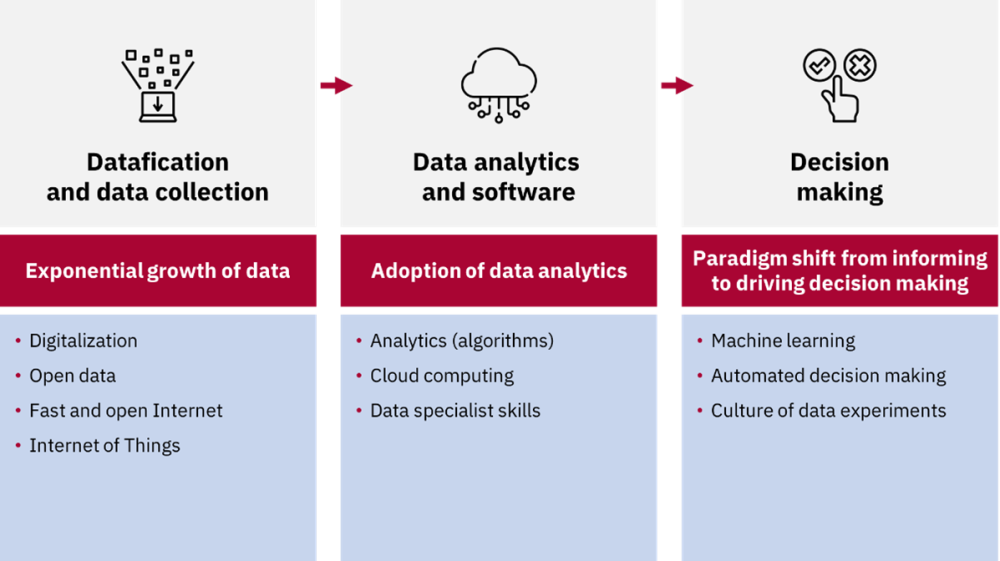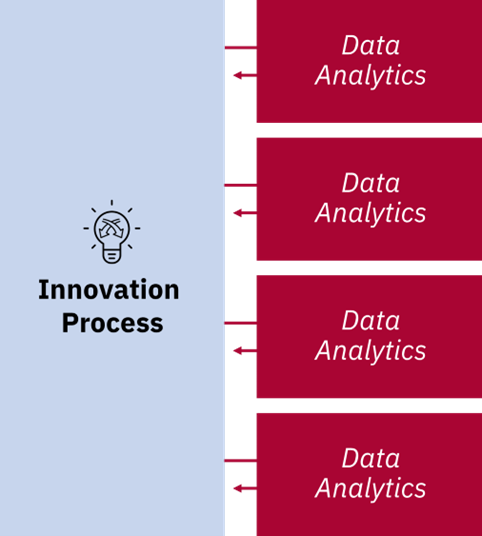What is business innovation and why is it important?
Innovation acts as a driver for organizational growth and a competitive advantage. Innovation makes it possible to differentiate the organization from competitors and to optimize the current offering to meet customer needs.
Despite innovation being a driver of growth and one of the biggest predictors of sustained success, there are still not many organizations that can innovate continuously and, most importantly, extract tangible results from their innovation efforts. Often, this lack of alignment between innovation initiatives and their results is caused by the need for an adequate strategy for each organization’s situation.
Without an innovation strategy, the effort to create breakthrough products or services can easily fizzle out in the organization. For investment in innovation to yield breakthrough results, it is necessary to designate a dedicated innovation team and define a strategy based on accurate and valid data. Otherwise, crowdsourcing, open innovation, and external alliances may be useless to the organization. Thus, data analysis plays a vital role in creating an innovative strategy suitable for the organization.
Data analysis and innovation
Data is an emerging resource for organizations, enabling value creation and the development of new industries, products, and processes. The use of data to create value and reach new horizons is called data-driven innovation.
This type of innovation is based on three growth-catalyzing practices: collecting data, using data analysis techniques and methodologies, and leveraging data in decision-making. Adopting these practices and moving to a new data paradigm streamlines companies’ innovation efforts, resulting in more innovation and reduced time-to-market.

A data-driven innovation process involves the use of several types of complex, constantly evolving information that needs to be processed for it to be helpful to the organization. Information regarding consumer trends, customer communication preferences, and the performance of products and services in the marketplace are all relevant data for developing new innovations.
What is data analysis / data analytics?
Data analytics is the process of analyzing data to uncover trends and connections between different types of information from which conclusions are drawn. Through data analytics, it is possible to solve highly complex problems and make decisions based on advanced analytics and digital solutions.
In an organization, the correct use of data analysis enables informed decisions to be made, which can determine the innovation investment, risk, and success. Data analytics encompasses a range of applications from business intelligence, reporting, and analytical processes, to advanced analytics methodologies. When data analysis is employed correctly, it can increase business profit, improve operational efficiency, optimize marketing efforts, and structure customer service. In addition to driving the business ahead, data analytics enables organizations to respond quickly to market trends and achieve a competitive advantage.
Big data
When the volume of information reaches a critical point where the amount of data cannot be manually analyzed, the topic of big data arises, requiring new processing, storage, and the use of data.
Big data is relevant to the innovation efforts of organizations because it allows the streamlining of processes, the discovery of new business models (generated from its analysis), and the discovery of new products, services, and strategic partnerships between companies that can exchange information generated by the large volume of data. Furthermore, with big data, it is possible to identify trends in the volume of consumer clicks on shopping websites and consequently develop new products and services tailored to their needs.
What are the main difficulties in innovation, and what is the role of big data in mitigating them?
The innovation process is not linear. New difficulties and barriers to innovation often accompany increased investment in innovation. If these difficulties are not surpassed, it can limit the return on investment in innovation. Big data can overcome these factors and revolutionize the innovation process of organizations, solving structural problems such as:
1. Unrealistic expectations for innovation
Creating unreasonable expectations can lead to an organization losing confidence in a project. Unattainable goals, impossible deadlines, and short testing times are problems that a data-driven innovation strategy can overcome. The analysis (and cross-referencing) of a large data set allows you to reliably define the project’s duration and the resources needed to allocate.
2. Lack of innovation strategies
The main benefit of big data and a data-driven innovation strategy is that it allows the organization to analyze a large set of opinions, trends, innovation strategies, and outcomes. A data-driven innovation process allows us to identify patterns between different innovation strategies and to understand what works or not by cross-referencing data from organizations with a similar core business or innovation.
However, more than the analysis of big data is needed to ensure the appropriate choice of innovation strategy; it is necessary to consider the organization’s culture and the available budget to understand the viability and return on each strategy.
3. Difficulty in the transition between the phases of the innovation process
The management of the innovation process, after the definition of the strategy, can also be supported by big data. When the innovation strategy is new to the organization, it is necessary to re-adjust the process over time. For this, big data, along with the experience gained by the organization, can help define the path.
4. Incorrect innovation KPIs
The measurement of innovation efforts through KPIs is fundamental to ensure the continued success of innovation. However, the choice of KPIs to be analyzed must be adjusted to the previously defined goals. KPIs such as sales volume and business revenue may not be the most appropriate ones to measure at an early stage, risking isolating the financial vision of the project.
An analysis of KPIs with little relevance may result in demotivation of the group assigned to the project, as well as the innovation’s discrediting in the stakeholders’ eyes.
5. The timespan of big data
The high volume of data collected allows the organization to predict, analyze and decide with high reliability. However, this analysis tends to be representative only of the present and usually lacks the history of the data concerned. It is necessary to consider the past of the market and of the organization, and to support decision-making regarding these factors, along with the big data currently being collected.
6. Lack of data security
Another limiting factor in the use of big data is the security of the data used during the analysis process and the execution phases of the innovation. During the data analysis process, the company must ensure data integrity by adopting a parity system where raw and analyzed data are compared at any given time. This system prevents the loss or deviation of the collected data.
How do you develop a data-driven innovation strategy?
As this is a revolutionary process for an organizations’ innovation strategy, data must be presented to the organization in a way that all stakeholders accept. To this end, defining how to start the data-driven innovation process is necessary.
A data-driven culture of innovation starts at the top
Companies with a strong data culture tend to internally spread the importance of grounding strategic decisions in data. This requires leading by example and highlighting the benefits of data-driven decision-making among the collaborators. The management team has to be the first to rely on data for their decisions, so that this notion is accepted throughout the company, especially in innovation departments.
Integration of data analytics throughout the innovation process
The innovation process entails testing and adjustments culminating in developing a profitable product or service. It is critical to ensure that data is integrated throughout the process, not just at the beginning of the innovation development. Whether it’s through audience testing, MVP (Minimum Viable Product) creation, or process improvement, data analysis is critical throughout the process.

Agile problem solving
Big data supports organizations’ innovation efforts as it enables better decisions to be made in less time. The organization must be trained to keep up with data access and processing speed, ensuring that the company takes advantage of this tool. Without information, the company stagnates and does not evolve; however, access to information does not guarantee results. It is essential to monitor the organization and solve problems in an agile way that may arise during the discovery process of the data-driven innovation culture.
It is necessary to excel within regulated data management, in which the analysis tools are introduced to the collaborators gradually, so that everyone learns how to optimize their data analysis process.
Continuous training of collaborators
Training is critical. However, it must be spaced out over time, ensuring that basic skills (such as coding) and other specialized analytical concepts and tools are acquired and tested in different contexts. Thus, training the collaborators continuously allows them to consolidate the acquired knowledge and prepare for more challenging contexts.
Nowadays, it is crucial to ensure that the innovations developed are cost-effective and that the company spends as few resources as possible to deliver a valuable product to its customer. The use of data analytics streamlines organizations’ innovation processes and provides real-time insights for the development of new products and services.
Do you still have questions about data analysis and innovation?
What are data-driven innovations?
Data-driven innovation refers to using data and analytics to create new products, processes, organizational methods and develop new markets. Data and analytics can drive both the discovery and execution of innovation, achieving new business models, products, or services.
What is an innovation process?
A process of innovation is implementing a new or significantly improved production or delivery method. This includes significant changes in techniques, equipment, and/or software.
What is demand and supply forecasting?
Demand and supply forecasting refers to the process of planning or predicting the demand of materials to ensure the delivery of the right products and in the right quantities to satisfy customer demand without creating a surplus.
See more on Innovation
Find out more about transformation in this sector
See more on Analytics
Find out more about improving this business area
